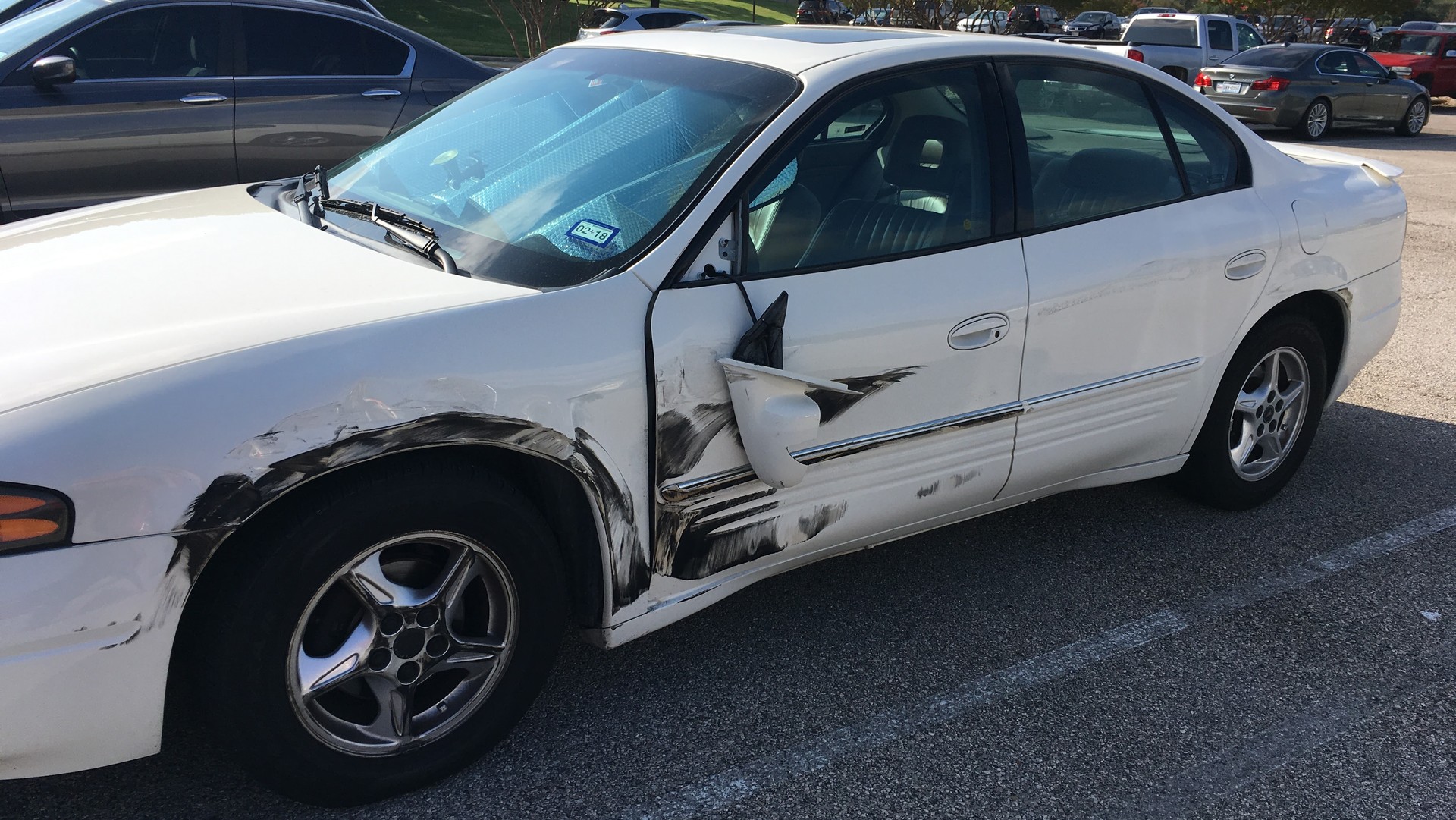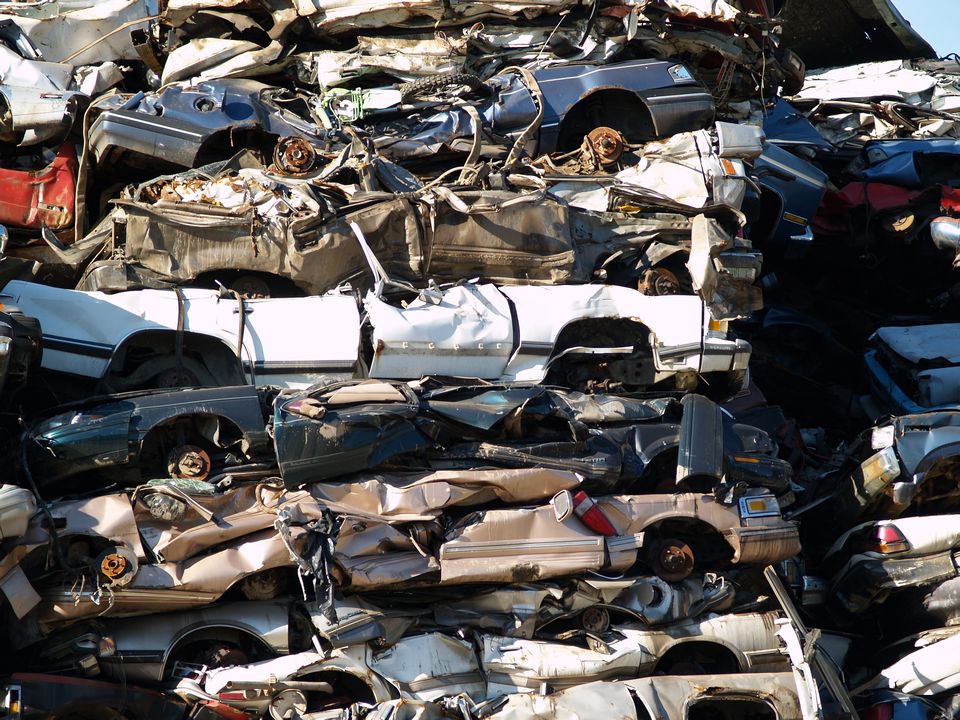My wife was recently the victim of a hit and run. It was a traumatizing experience for her, but luckily she's fine. The car she was driving at the time, my 2002 Pontiac Bonneville, didn't fare as well. My insurance declared it a total loss. I learned a lot about accidents and insurance that I think you should know too.
The Collision
My wife was driving southbound on US-75 in Dallas in the second lane from the left. A black pickup truck was going faster than my wife in the leftmost lane. As the pickup was passing my wife, it side-swiped her. After hitting my wife, the pickup truck sped up and weaved in and out of traffic to get away from my wife as fast as possible. The driver obviously had no intention of hanging around.
The approximate location of the hit and run.
My wife saw his license plate and tried to remember it, but she was so scared that she ended up forgetting a few of the characters. We think what she saw was a Texas license plate. She wrote down that the plate was number "M?? 9556". She forgot the last two letters in the group of three, and she's not 100% sure that the last two numbers in the group of four is "56". Also, she remembers that the truck was not a very tall truck.
The Immediate Aftermath
The truck hit my wife pretty hard; she said it pushed her over almost into the next lane. Luckily, she was able to maintain control of the car and avoid hitting any guard rails or other vehicles. She pulled off the highway at the next exit, drove into a Walmart parking lot, and called me.

My poor 2002 Pontiac Bonneville after the accident.
She didn't know exactly what to do in an accident in America because she's Korean, but she remembered that I told her the first thing to do after an accident is to go to a safe place away from the road. I'm really proud of her for doing that because some people can't do anything at all after an accident due to their shock.
I took a taxi from my office to where she was and made a few phone calls to figure out what to do next.
Reporting the Hit and Run
I called the local police station to report the accident. They told me that since all of the vehicles involved in the accident were still operable, I would have to come in to a police station to make a report. Annoying. I asked if the car was still legal to drive without one side-view mirror. The officer told me that driving it was up to my discretion.
We drove to the nearest police station (that we found with my phone since the officer I spoke with didn't seem to know the location of all the police stations in Dallas. (There's only 8 including headquarters.)
Once we got to the police station, we had to wait about ten minutes before an officer spoke with us and were told that we would have to fill out two forms and deliver them to two different addresses. One form was for the Texas Department of Transportation in Austin (for statistics purposes, I guess) and another was for Dallas PD.

Dallas Police Department badge.
Since the form for the Dallas PD had to be given directly to the records department all the way in Downtown Dallas, I opted to just mail both of them.
Dallas PD only makes the TXDOT form available on its website. They should make both forms available online so you don't have to waste a trip to a patrol division just to pick up a form. (This is especially a problem because these are accident report forms, so people might not be able to easily make it to a patrol division to pick them up when they need them.)
Insurance - Before the Accident
I had recently updated my insurance coverage. Old cars need less insurance than newer cars, so I was trying to save a little money by reducing my coverage. My car is 15 years old after all.

My insurance at the time of the accident.
I had tried to remove my comprehensive and collision coverage, but due to a couple glitches with State Farm's website, I was unable to do this online. Deterred, I left it for another day.
Insurance - Deductible
In the case of a hit and run, there are two ways a claim can be handled. If the insurance company doesn't believe that it was actually a hit and run (because your car looks like you hit a dear), then the claim will be processed under your collision coverage. For me, that meant a $1000 deductible if that was the case.
In our case, we filed a police report, gave a copy of that police report and the case number to State Farm, and the damage to the car looked like damage that would happen when what we said happened in the police report happens. Due to this, State Farm processed out claim under Uninsured Motorist - Property Damage. This carries only a $250 deductible.
Insurance - Total Loss
I had the car inspected by State Farm, and they determined that the cost to repair the vehicle was more than cash value of the vehicle before the accident; they declared it a total loss.
Although the damage to the vehicle was mostly cosmetic, the truck managed to damage the front bumper, right front fender, right front door, right rear door, right rear quarter, and rear bumper. Each panel that gets damaged, even if the damage is very slight, increases the cost of repair by several hundred dollars because that panel has to be completely repainted.

My car's value as determined by Kelley Blue Book on 8/19/2017.
I had recently checked the value of my car on KBB, so I expected them to declare it a total loss. According to KBB, if my car was in excellent condition (that's the top 3% of cars according to them), then it would be worth about $2,276.
Insurance - Settlement
The settlement the insurance company offered me was very generous. They estimated my car's pre-accident value at $3406 and it's post-accident salvage value at $333. In the case of a total loss, you have two options. Option 1: keep your car and get a check for the value of your car before the accident minus your deductible and the salvage value of your car. Option 2: surrender your car and get a check for the value of your car before the accident minus your deductible.
| Actual Cash Value | $3,406.00 |
| Taxes | +$212.88 |
| Total Loss Fees | +$76.86 |
| Deductible | -$250.00 |
| Retained Salvage Value | -$333.00 |
| Total | $3,112.74 |
State Farm's settlement offer.
In my case, the choice was obvious. My car was still in working condition, and if I gave it up I'd only get an extra $333. Basically I had to decide if my damaged car was worth more or less than $333.
Considering how good the condition of the rest of the car was, I kept it. I figured I could get a new door, right fender, and mirror for several hundred dollars and then pocket the rest. I don't really care about the scuffs on the other panels. My car is pretty old, so who cares what it looks like? It's my reliable clunker.
Insurance - Post Settlement
Since State Farm declared my car a total loss, it is now worth $0 in their eyes. Because of this, I can no longer have comprehensive or collision coverage on it. This makes sense.
Collision coverage pays to repair your car if you hit something like a tree or pole. Comprehensive coverage pays to repair your car if it catches on fire or is damaged by hail. In either case, insurance wouldn't pay anything to repair it to it's previous condition because it wasn't worth anything to begin with.
Since I can't have those two kinds of coverage anymore, I get to save a little money on each premium payment now.
Salvage Titles
The laws for total losses vary from state to state. In Texas, it's not uncommon for a car to be declared a total loss after a hail storm even though the car is perfectly fine mechanically and only needs a new windshield. For this reason, Texas calculates the cost of repairing a car twice for total losses.
First, the total cost to repair the car is calculated to determine how much the insurance company should pay out. This includes the cost of parts and labor for getting the car running again and parts and labor for repainting the car.
Second, the cost to get the car running again is calculated (omitting the cost of parts and labor for repainting the car.) This second calculation is used to determine if the car must get a salvage title or if it can retain it's normal title. If the cost to get the car up and running again is greater than the value of the car before the accident, then the car must get a salvage title.

What most people imagine cars with salvage titles look like. - [Jim Orsini](https://www.flickr.com/photos/orblivio/144522481/in/photolist-dLHuV-GrrMMN-4y29eD-nK53jQ-nQtQqF-36kcTA-nJVADW-nsCuTW-SZGiiQ-pGajy-nJVQR3-nJVTfw-nsDa5A-nK7JMa-dw4QjM-6QGbM-5WK3h4-9dCzHW-57D6AN-nLUgZc-nK8WP4-rG1tM-nLVtJH-dw4LjP-2sdRH5-5nKXGY-nJNV9K-49Nsf-pG24G-RcbSEk-4tChLN-Ue9hMU-tW9rt-rG1Jn-5cfZm-nK4Gby-7shPq-nsDPVD-6QG8J-6mTYb6-UiNDCa-7s7zc8-4i33V2-6QGg5-49NrZ-rG1pV-nK5gDq-dbdvRZ-2sdREy-TDDBxj)
Cars that have salvage titles have drastically reduced values and sell for much less. Salvage titles cannot be converted back into regular titles after the car is repaired except by taking advantage of a few legal loopholes and selling the car across several state lines.
In our case, most of the damage to our car was cosmetic, so the total cost to repair was 101% of the car's value, but the cost of the repairs minus the cost of repainting was only 49% of the car's value. Because of this, the car was a total loss as far as insurance was concerned, but I did not have to get a salvage title for it.
Conclusion
I haven't had time to take the car to any body shops to get estimates, so I don't know how much it will cost to repair. I might or might not update this blog post when I find that out.
Either way, I'm happy with the way State Farm handled my claim. The only reason I had State Farm insurance is because my parents had State Farm insurance and they told me they never had any problems with them. When they made a claim, State Farm always paid them a fair amount. I'd say I had the same experience with them.